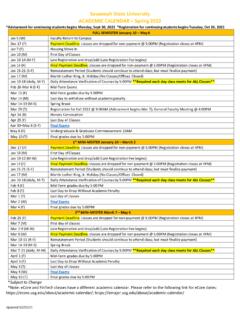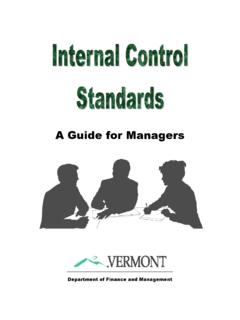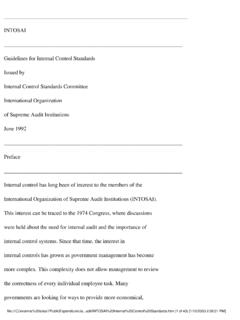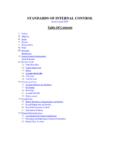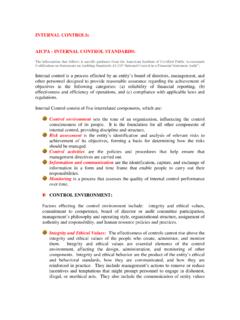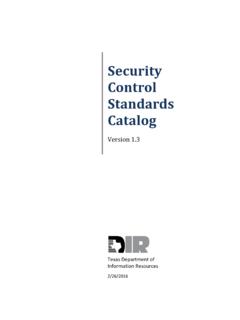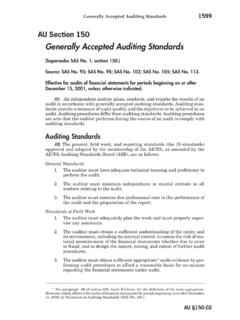Transcription of Understanding Internal Controls
1 Understanding Internal Controls A Reference Guide for Managing University Business Practices Introduction As servants of public trust, the University System of Georgia (USG) has a great responsibility to utilize the resources provided in the most effective and efficient ways possible while adhering to laws and regulations. A strong system of Internal Controls is paramount to properly managing USG s resources within the related business processes. Every employee within the USG has some role in effecting Internal Controls . Roles vary with responsibility, however, Business Officers play a key role in assuring that high standards of business and ethical practices are followed because they are ultimately responsible for the appropriate use and control of the resources entrusted to them. The purpose of this section of the BPM is to assist employees in their stewardship role in achieving USG s objectives and to provide guidance for the existence of basic and consistent business Controls throughout the USG and to define responsibilities for managing them.
2 It addresses the following five interrelated components of Internal control in relation to developing business control systems: The organization's operating ( control ) environment Goals and objectives and related risk assessment Controls and related policies and procedures Information systems and communication methods control Activities to monitor performance This guidance is based upon the Internal control guidelines as recommended by the Committee of Sponsoring Organizations (COSO) of the Treadway Commission. COSO was formed to support the Commission's recommendation to develop additional, integrated guidance on Internal control . Objectives The objectives of this Section are as follows: 1) Convey to you that management is responsible for ensuring that Internal Controls are established, properly documented, maintained and adhered to by each institution from top management all the way down to the Department level.
3 2) Convey to you that all employees of the USG are responsible for compliance with Internal Controls . 3) Provide guidance to help managers and staff understand the components of Internal control , how those components interrelate when developing a system of Internal Controls and provide tools to establish, properly document, maintain, and adhere to the Institution s system of Internal Controls . Scope This guidance applies to all of the Institution s departments and operations. The examples of control activities contained in this guide are not presented as all-inclusive or exhaustive of all the specific Controls appropriate in each department or unit. Over time, Controls may be expected to change to reflect changes in your operating environment. An effective control system provides reasonable, but not absolute assurance for the safeguarding of assets, the reliability of financial information, and the compliance with laws and regulations.
4 Reasonable assurance is a concept that acknowledges that control systems should be developed and implemented to provide management with the appropriate balance between risk of a certain business practice and the level of control required to ensure business objectives are met. As a matter of practical application, the cost of a control should not exceed the benefit to be derived from it, unless mandated by a higher authority. The degree of control employed is a matter of good business judgment. When business Controls are found to contain weaknesses, we must choose among the following alternatives: Increase supervision and monitoring; Institute additional or compensating Controls ; and/or Accept the risk inherent with the control weakness (assuming management approval). The guidance presented here should not be considered to "stand alone." This guidance should be used in conjunction with existing policies and procedures.
5 Responsibility All employees of the University are responsible for managing Internal Controls . Each Group, Business Unit, or Department Head is specifically responsible for ensuring that Internal Controls are established, properly documented, and maintained in each organization. There are many resources to assist employees in managing their areas of responsibility for Internal control systems and processes. Primary resources include the campus CBO, Controller, and campus auditors. In general, while all employees are responsible for the quality of their Internal Controls , CBOs and Controllers are responsible for providing campus leadership to ensure that effective Internal control and accountability practices are in place. Campus auditors normally assist management in their oversight and operating responsibilities through independent audits and consultations designed to evaluate and promote the systems of Internal control .
6 Balancing Risk and control Risk is the probability that an event or action will adversely affect the organization. The primary categories of risk are errors, omissions, delay and fraud. In order to achieve goals and objectives, management needs to effectively balance risks and Controls . Therefore, control procedures need to be developed so that they decrease risk to a level where management can accept the exposure to that risk. By performing this balancing act "reasonable assurance can be attained. In order to achieve a balance between risk and Controls , Internal Controls should be proactive, value-added, cost-effective and address exposure to risk. Characteristics for Fraud There are generally three requirements for fraud to occur - motivation, opportunity and personal characteristics. Motivation is usually situational pressures in the form of a need for money, personal satisfaction, or to alleviate a fear of failure.
7 Opportunity is access to a situation where fraud can be perpetrated, such as weaknesses in Internal Controls , necessities of an operating environment, management styles and corporate culture. Personal characteristics include a willingness to commit fraud. Personal integrity and moral standards need to be flexible enough to justify the fraud, perhaps out of a need to feed their children or pay for a family illness. It is difficult to have an effect on an individual s motivation for fraud. Personal characteristics can sometimes be changed through training and awareness programs. Opportunity is the easiest and most effective requirement to address to reduce the probability of fraud. By developing effective systems of Internal control , you can remove opportunities to commit fraud. Internal control Defined Internal control is a process, affected by management, designed to provide reasonable assurance regarding the achievement of objectives in the following categories: Effectiveness and efficiency of operations Reliability of financial reporting Compliance with applicable laws and regulations Several key points should be made about this definition: 1) People at every level of an organization affect Internal control .
8 Internal control is, to some degree, everyone's responsibility. Generally, administrative employees at the department-level are primarily responsible for Internal control in their departments. Consequently, the responsibility for Controls over accurate financial and reporting primarily falls under the oversight of Institution s Business Officers. 2) Effective Internal control helps an organization achieve its operations, financial reporting, and compliance objectives. Effective Internal control is a built-in part of the management process ( , plan, organize, direct, and control ). Internal control keeps an organization on course toward its objectives and the achievement of its mission, and minimizes surprises along the way. Internal control promotes effectiveness and efficiency of operations, reduces the risk of asset loss, and helps to ensure compliance with laws and regulations. Internal control also ensures the reliability of financial reporting ( , all transactions are recorded and that all recorded transactions are real, properly valued, recorded on a timely basis, properly classified, and correctly summarized and posted).
9 3) Internal control can provide only reasonable assurance - not absolute assurance regarding the achievement of an organization's objectives. Effective Internal control helps an organization achieve its objectives; it does not ensure success. There are several reasons why Internal control cannot provide absolute assurance that objectives will be achieved: cost/benefit realities, collusion among employees, and external events beyond an organization's control . Internal control Process Internal control consists of five interrelated components as follows: control (or Operating) environment Risk assessment control activities Information and communication Monitoring All five Internal control components must be present to have effective Internal Controls . Also, when considering the five components of Internal control , certain components relate more to the organization as a whole, while other components relate to specific financial reporting areas or transaction classes.
10 The following table illustrates the distinction between organizational (high level) Controls and functional (activity/transactional) level Controls : Components of Internal control control Environment Risk Assessment Information and Communication control Activities Monitoring Primary Level of Application Organization Level Communication Functional(Activity Level) Information Systems The remainder of this document will be devoted to discussing the 5 components of Internal control in detail and provide the following: 1) Show interrelationships between the various components of Internal Controls 2) Provide suggestions to help improve effectiveness 3) Provide sample forms to assist in the documentation of Internal Controls ORGANIZATIONAL LEVEL Controls control Environment The control environment sets the tone for the organization and influences how employees conduct their activities and carry out their control responsibilities.

